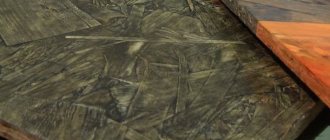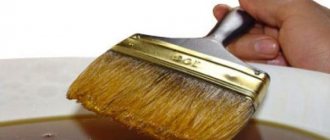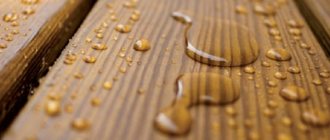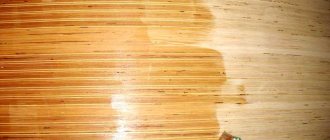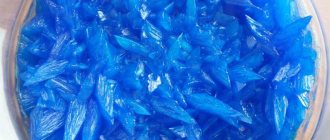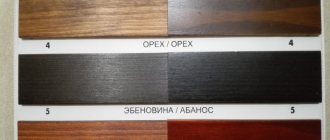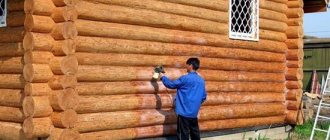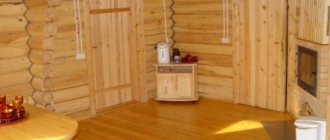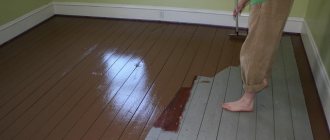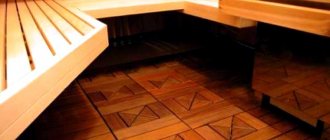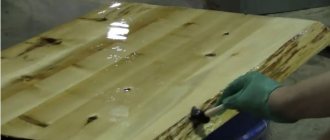The most popular finishing material for a bathhouse is lining; it is made from aspen, alder, pine, and linden boards are often used. This type of cladding is characterized by high performance characteristics: strength, resistance to moisture, steam, and temperature changes.
In order for the wood used to last as long as possible, it must be coated with special compounds that protect against the formation of rot and deformation.
Why treat the floor in a bathhouse?
Impregnation for the floor in the bathhouse is needed against moisture and rotting. Modern materials have a complex chemical composition. In addition to the antiseptic, components are introduced that clog the pores of concrete and wood, reducing the water absorption of materials. High-quality impregnation has a triple effect:
- Water-repellent, moisture does not penetrate into the material;
- Fungicidal, destroying fungal spores and mold cells;
- Repellent, effective against insect borers.
Concrete used for subfloors is easier than wood. It is enough to saturate the surface with a moisture-resistant organic composition, after polymerization of which the porous surface is covered with a thin layer of glass. Bacteria do not nest on the protection. The tree becomes more resistant to external factors. The floor is treated in all parts of the bathhouse: steam room, washroom, dressing room. Although the load on the flooring in the place where people rest after washing is much lower than in wet areas, treatment is necessary.
Wood often suffers from rot when insect larvae chew through passages inside the board.
Impregnation for the floor in the bathhouse is needed against moisture and rotting.
Localization
The bathhouse consists of several compartments, some of which are highly susceptible to mold:
- Steam compartment. There is often no window or ventilation. The room dimensions are small, the temperature and humidity are high.
- Waiting room. Damp, warm room. Microclimate conditions are favorable for breeding large-scale colonies of molds.
- Shower room. A small room without windows. There is constant humidity around the pan, in places where water drains.
- The inner surface of the walls where the bath broom is hung. A damp object in an unventilated room takes a long time to dry, and dampness between the product and the side of the room remains for a considerable time.
- Joint of logs. If the bathhouse is built of timber, moisture accumulates between the structural elements.
- Bath shelves. Water often remains on the outer surface of products. If the liquid is not removed, a favorable environment is created for fungi.
Sauna owners were a little luckier. Dry air inside the steam compartment and high temperature conditions prevent the spread of mold.
Corner areas of the room are considered the most susceptible places. Even in a well-ventilated room, air flows in poorly. The ceiling often suffers from mold. Due to the accumulation of warm air masses, condensation appears. Moisture accumulates on the inside and drops form. Late detection of mold leads to a large-scale spread of infection to clean areas of the building.
The fungus often takes root on wooden materials and lining. Concrete and brick are less susceptible to mold, but there is a risk. No type of building materials is protected from damage.
Causes of wood rotting
Wood is a porous structure made of plant fibers that absorbs water well. When the material humidity is above 15%, the risk of infection increases.
Wood is an organic medium in which, under certain conditions, bacteria and fungal spores actively develop. Microorganisms need temperatures in the range from 0 to +50°C, humidity above 80%.
Favorable factors for the development of mold and fungi are considered to be freezing of boards, stagnation of indoor air, and possible contact with soil.
Wood is an organic medium in which, under certain conditions, bacteria and fungal spores actively develop.
Features of log operation
Wooden structural elements during operation are not directly exposed to all kinds of natural factors, such as precipitation and wind. As a rule, there is no direct contact between the logs and the natural environment.
Sometimes dampness can damage them only if they are laid on a damp foundation. But when installing logs, property owners strive to prevent the beams from coming into contact with the external environment. In this case we are talking about the device of vapor and waterproofing.
We suggest you familiarize yourself with How to treat the inside of a bathhouse so that it doesn’t get dark
Since wood is highly susceptible to rotting processes and mold fungi can intensively multiply on it, it must be protected from adverse external factors.
Do I need to treat wooden surfaces in a steam room?
Even if construction technology and good insulation are followed, it is recommended to treat the internal lining of the steam compartment. This procedure will increase the strength and durability of lining made from any type of tree. Without protection, the tree will quickly darken and the structure will begin to collapse. Inside the steam room, not only the floor, but also the shelves are treated. Choose safe formulations from natural or artificial ingredients. If the wood is not treated, after 2-3 years you will have to re-sand the wooden surfaces to give it an aesthetic appearance. Rotten wood smells unpleasant and can cause allergies and lung diseases.
The ancient folk method of treating boards with heated linseed oil is more expensive and less practical compared to modern impregnations.
Inside the steam room, not only the floor, but also the shelves are treated.
The better
Let us clarify that treatment, in our understanding, is a preventive measure to prevent the future appearance of rot, mold, blue stains, infestation with wood-boring beetles and similar misfortunes. Or medicinal if infection has occurred. There are also compositions to reduce the flammability of wood.
In the first two cases we are talking about antiseptics - substances that kill fungi (fungicides) and insects (insecticides). In the third case - about fire retardants, which slow down fire or make wood non-flammable.
Is it necessary to treat the lining in a bathhouse with these compounds? Optional. They are good for preventing infections, they will keep the sauna from burning out completely, but they have restrictions on their use in the steam room
It is also possible to pay attention to impregnated wood
What to use in the steam room
While we're talking about this, there are a couple of products that can be used in a steam room too. However, their effectiveness is very limited.
For example, if you treat the paneling in the steam room of a bathhouse with “Belizna” bleach or its analogues, you can quickly get rid of the blue stain - this is the name of the fungal infection of wood, with which wood is often sold, since it does not affect the strength, it only spoils the appearance of the lumber.
Fungal infection - blue
BY THE WAY! Why Whiteness? Because there are a number of different antiseptics for wood, which contain nothing but sodium hypochlorite, as in “Belizna”. Well, maybe the concentration is different and the price is different.
After use and achievement of the result, “Whiteness” is washed off and ventilated (!more about ventilation in the bathhouse in a separate material). You can use the bathhouse when you can no longer smell the smell.
As a close analogue of bleach, you can use hydrogen peroxide - also a strong oxidizing agent that does not allow fungi to live.
For mold, you can use boric acid or borax, but now boron compounds are considered toxic, and among the cumulative poisons, that is, those that accumulate and are not eliminated from the body. The only good thing is that the poison is weak, it takes a lot of it to get poisoned.
But it’s not worth living with mold either; you die from it faster than from boron. If it starts up, then it’s no longer a matter of whether it’s a steam room or not, we have to start fighting. Until you get rid of it, you can’t use the bathhouse.
However, this applies to all infections - the more serious they are, the more serious the remedies. It’s better to treat the lining in a bathhouse with a professional antiseptic that will combat your problem, and then wash everything, than to change the entire lining. But it’s better to change the entire paneling than to risk your life because of black mold. With wood-boring beetles, the same strategy - while it makes sense to fight - we fight, if there are too many of them - we burn the affected tree.
Treatment inside other bath rooms
In this case, there is only one difference from the steam room: in other rooms you can use prophylactic agents. That is, do not wait for a problem, but prevent its occurrence by poisoning the lives of pests in advance.
Since there is no steam room heat in other rooms, all these poisons will not evaporate and be inhaled by humans.
Therefore, you can safely use antiseptics and fire retardants, whichever you like. In the washroom you will want to use non-washable compounds, but look at the label: if it says that it is for the exterior and not the interior, then it is better not to. It's better to update from time to time.
IMPORTANT! Antiseptics can be found on sale not only in the form of separate formulations, but also in the form of primers, which precede the application of varnish, glaze or paint. If you are going to paint with something, choose the right primer and you will not need to separately use an antiseptic.
Requirements for anti-putrefactive agents
The main properties that chemical compositions must have to protect wooden structures are approved by GOST 20022.6-93. Substances used to protect the internal surfaces of buildings from harmful factors (including damage by microorganisms) must be environmentally friendly. Anti-rot impregnations contain fungicides and antiseptics. These components protect lumber from rotting and other types of biological destruction.
Substances used to protect the internal surfaces of buildings from harmful factors must be environmentally friendly.
Types of floor impregnations
Compositions for wooden floors can be antibacterial, moisture-proof and combined; for concrete they produce dust-removing, strengthening and moisture-repellent compounds. For the subfloor in the bathhouse, only the latter are needed, forming a glassy surface film.
Before deciding how to saturate the floor in the bathhouse, it is advisable to know the features of the various compositions. Manufacturers offer a wide selection of impregnations based on:
- Water;
- Mixtures of organic alcohols;
- Vegetable and mineral oils;
- Mixtures of compatible base components.
For steam rooms, water-soluble compounds are usually chosen; alcohol-based ones are used only for affected wood. Any impregnation is suitable for the washing compartment and dressing room; the choice is made based on the condition of the wood used and the density of the wood. After drying, moisture-proofing agents reliably clog wood pores. The degree of protection depends on the depth of penetration; this indicator is usually indicated on the packaging.
Different types of wood require their own protection categories; it is advisable to check with the seller whether the composition is suitable for the floor.
After drying, moisture-proofing agents reliably clog wood pores.
Why is this necessary?
Painting concrete solves several problems at once:
- First of all, the concrete floor is painted to prevent dust. The surface of concrete gradually collapses even in literally greenhouse conditions - at stable temperature and humidity; the rate of surface destruction increases many times with fluctuations in these parameters.
So, in a bathhouse with its periodic heating there will be much more dust than in a constantly heated workshop;
- Painting or impregnation will significantly delay the time of the next repair. The notorious mechanical and temperature effects, uneven moisture (for example, melted snow from the roof of a car), fuel and electrolyte from the battery inevitably spilling onto the floor will sooner or later decorate the floor with chips;
- Finally, don't forget about aesthetics. In fact, who would like the dull gray color prevailing in the room?
Painted concrete floor in a gym.
Application of impregnations at the stages of construction and operation of a bathhouse
It is much easier to cover disassembled elements than a finished floor. It is better to soak the boards in the sun; under the influence of ultraviolet radiation, moisture evaporates faster from the deeper layers. Concrete does not need secondary treatment, but wood is renewed after long-term use: the top layer of wood is removed with a sander, then treated with bleaches and impregnations.
Only those areas that have not brightened after sanding are treated with bleach. It is not recommended to bleach all wood completely, although the compositions are considered safe, they still contain some chemicals.
It is better to soak the boards in the sun; under the influence of ultraviolet radiation, moisture evaporates faster from the deeper layers.
Useful video
Yes, it was surprisingly difficult to find a sane video. We stopped at this video because in it you will find references to compounds that were not found in our text - from the company TEKNOS. She is famous, she has facilities in Russia. Why not?
***
Finally, we would like to invite all of you to be more demanding customers, ask for the composition of the chemicals you are going to purchase and the certificates for it. Your health depends on this, so I would like to see real information, and not streamlined formulations.
Surface treatment technology
For concrete, one layer of protective coating is sufficient. The wood is pre-sanded and washed. The compositions are applied only to well-dried surfaces, taking into account the manufacturers' recommendations. The liquid material is applied in 2 or 3 layers depending on the type of wood, observing a time interval of at least 40–50 minutes for the wood to dry. It is allowed to combine the compositions; antibacterial impregnation can be applied to a friend protected from moisture. It is more convenient to use complex formulations.
Sauna wax is applied using a cloth or a special disc machine. A day is enough to completely dry wax coatings; regular ones last up to 3 days. When areas with moldy lesions are identified, first remove the mold with a sponge moistened with an antiseptic; it is better to use the drug “Nortex”. The mixture is applied for 2 hours before treating the wood with impregnation. To bleach boards darkened by moisture and heat, use certified bleaches or choose mixtures containing such components.
If the floor is damaged by a grinder, use alcohol-based compounds. Liquid is drawn into a syringe into the damaged areas, all passages and the surface next to them are filled.
The compositions are applied only to well-dried surfaces, taking into account the manufacturers' recommendations.
Indicators of timber suitability
It is necessary to know about the origin of the wood from which the joists are supposed to be made, because this mainly affects the quality of the floor. When wood is cut for the first time, it must be treated with an antimicrobial compound. Moreover, this must be done in the first 12 hours after sawing.
The next significant factor is drying. There are standards established in 1925, according to which all timber must be stored in a closed warehouse for a certain period. For coniferous trees this period is approximately 1 year, for oak – more than 2 years. In this case, the percentage of humidity is significant, which for spruce and pine is 15-18%.
The logs in the bathhouse can collapse in 1-2 years if you use dry wood to make them and place them on a foundation that is not completely dry. Such timber, if treated with a preservative coating, will become a kind of incubator in which mold will multiply. Therefore, it is necessary to coat only the wood that has actually undergone all the necessary preparation and drying.
Tips for choosing impregnation
For wooden floors in rooms with high humidity (steam room, washroom), it is recommended to choose natural-based compounds, sauna wax. Any impregnation can be used in the dressing room, locker room and rest room.
Although concrete is not a nutrient medium, with constant condensed moisture, pockets of mold fungi are formed; wood-destroying biological cultures do not settle on concrete, only mold. Removing moldy deposits from concrete will not be enough; microorganisms remain in the pores. Before applying coatings, use the antiseptic metacid; it is less toxic than bleach and is closer in action to chlorhexidine.
You need to purchase only branded compounds from trusted manufacturers. Such products do not contain toxins hazardous to health. When treated wood is heated, these substances are released into the atmosphere. The pursuit of low cost can be harmful to health. Impregnations vary in component composition; manufacturers produce products for fresh lumber and partially damaged wood. It is better to carry out the work in the summer, so that it is easier to dry the bathhouse after treatment with impregnation.
Surfaces must be treated with a brush or roller; liquid toxic compounds must not be sprayed, as they negatively affect the respiratory system.
For wooden floors in rooms with high humidity (steam room, washing room), it is recommended to choose natural-based compositions.
When choosing a product to protect the floor in a bathhouse, take into account the microclimate of the premises and the level of humidity. You can protect your bathhouse floors from rotting yourself using special impregnations. When processing wood or concrete with your own hands, it is important to adhere to the sequence of technological operations. It is necessary to pre-clean and polish the surfaces for better absorption of the compounds.
Homemade recipes
There is a recipe for homemade wax impregnation, which includes beeswax and linseed oil, the ingredients are taken in equal proportions. The grated wax is melted in a water bath, and then it is mixed with the second component and allowed to cool.
It is recommended to use harmless protective materials to impregnate the walls of the steam room. The use of oils allows you to create a greasy film on the surface of a wooden structure and protect the wood itself from penetration deep into dirt. There is one minus here. For some time after contact with the treated surfaces, a greasy film will be felt, but soon the oil will be absorbed and partially erased, leaving only a protective film.
A good result is obtained after using melted natural wax. This impregnation is easy to do with your own hands. But the surface must first be thoroughly cleaned, degreased and only then wax applied.
